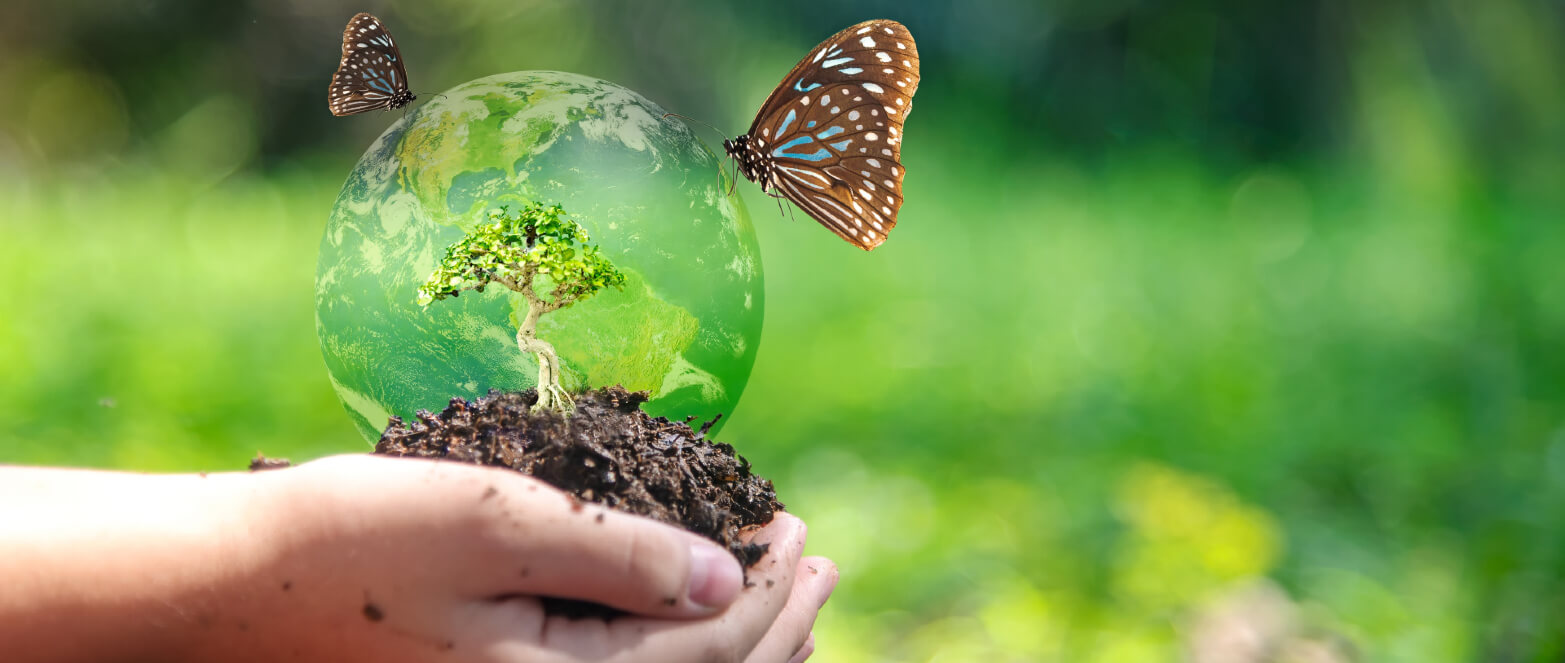Much has been said about the challenges facing the world – and agriculture – in the future. Concerns mount about a changing climate and the impact global warming will have on day-to-day life, food production, weather patterns, and extreme weather events.
One important concern with strong ties to climate change is biodiversity. Biodiversity supports our existence, but we can also cause harm to biodiversity through development and improved lifestyles. Agricultural biodiversity has a strong impact on sustainability and feeding the world of the future.
Biodiversity: a barrier to climate change
Biodiversity, or biological diversity, reflects the variety of all forms of life on Earth. Everything from small, single genes and bacteria to forests and coral reefs represents biodiversity.
Biodiversity can include whole ecosystems. It can also include the ecological and cultural processes that sustain life on Earth. Today’s biodiversity stems from almost 5 billion years of evolution. More and more, biodiversity is influenced by the activities of humans.
Biodiversity provides utilitarian needs for humans and other life on Earth. Food, fuel, fiber, shelter, and medicine are all tied to biodiversity. The biodiversity of whole ecosystems provides services in the environment such as nutrient cycling, climate regulation, and water purification. Biodiversity is also important for its cultural value and its future unrecognized value to medicines and other services. Biodiversity represents nature – and over half of the global GDP is reliant on nature.
Agriculture is rooted in nature. That’s why biodiversity is so important for the agriculture industry. Of all industries, it is heavily reliant on Nature. A healthy planet, good soil health, and a healthy environment lead to nutritious crops with high yields. Agriculture benefits from biodiversity and agricultural biodiversity can have major contributions to sustainability.
Biodiversity is at risk, and climate change has had an increasingly large role in biodiversity loss. In fact, they are closely linked. Ecosystems, such as marine, terrestrial, and freshwater, have been altered by climate change.
This has driven a loss of local species and mass mortality of plants and animals. Each lost species lowers the Earth’s biodiversity. The United Nations estimates that with three degrees of increased temperatures, 41% of mammals will lose half their habitat. Survival will be increasingly difficult.
Biodiversity loss can also contribute to climate change. 85% of wetlands that absorb carbon have been destroyed or disappeared. Ecosystems like the Amazon rainforest that were once carbon sinks have started to become carbon sources as they are deforested.
Biodiversity breakdown
The Earth’s biodiversity continues to collapse and threaten the world’s genetic diversity, food supply, and security. Nearly a decade after nearly every single country in the world aligned and signed off on 20 goals to address biodiversity, some progress has been made, but the U.N. convention says it’s just not enough. The World Economic Forum’s yearly global risk report even cited biodiversity loss as a significant, urgent threat to life on Earth. It’s estimated that since 1970, populations of mammals, reptiles, birds, amphibians, and fish that are closely monitored have dropped nearly 70%. The magnitude of biodiversity loss is great. Freshwater species have been particularly heavily hit. Latin America and the Caribbean saw the highest declines. Invasive species are also on the rise, threatening native species and biodiversity in those ecosystems.
This biodiversity loss is driven by a variety of factors. Habitat loss through deforestation and removal of mangroves and grasslands, overfishing, and pollution all impact biodiversity loss. Invasive species and intensive agricultural practices all impact biodiversity. Climate change, too, plays a role in biodiversity loss. It’s also is driven by biodiversity loss.

Biodiversity in agriculture
Expansive, intensive agriculture has driven biodiversity loss and ecosystem breakdown throughout recent history. The meaning of and focus on biodiversity in agriculture has been sidelined by intensive management practices. Biodiversity can be retained in farmland, influencing soil health, and it must be managed to be fully retained.
Agricultural biodiversity has changed over time. A loss in crop biodiversity has happened as farmers have focused on how to raise a few crops in an efficient way, however well-intentioned. This does have an effect on general biodiversity, too. Plant species cultivated by man have dropped in numbers from 6000 to fewer than 200 major species in food production. Just 9 species make up 66% of total crop production. If biodiversity is important for agriculture, why is it depleting?
The overuse of inputs in agriculture can impact the ecosystem and over time, decrease biodiversity. Sustainable agriculture practices that promote judicious and appropriate use of inputs can increase biodiversity. Poor land and water management and overharvesting in the process of agricultural production can also negatively impact biodiversity.
Loss in biodiversity is not limited to agricultural crops. Livestock and fish species are also facing serious drops in biodiversity. Questions of how to maintain habitat alongside agriculture production abound. How do animal agriculture and aquaculture influence a biodiverse ecosystem and affect agricultural sustainability contributions?
Benefits of biodiversity in agriculture
To learn more about how biodiversity benefits agriculture, we talked to Cristian Terrones, Sustainability Specialist of ICL’s Agronomy Team. Cristian tells us “Biodiversity plays a crucial role in supporting agriculture, productivity, and sustainability. Some of the benefits include:
- Pest and disease control: the more biodiverse a system is and the more incidence of fauna, fungi, and microorganisms present helps to keep pest populations in check without using synthetic pesticides. Not all plagues need to be controlled with pesticides, many of them have natural control agents which will thrive if biodiversity is abundant.
- Soil Health: the quantity and diversity of the soil’s microbiome are important for many aspects of soil health including nutrient cycling, soil structure, and soil resilience. Biodiversity helps maintain soil health by decomposing organic matter, increasing Nutrient Use Efficiency (NUE), improving soil structure and physical characteristics, increasing soil fertility, improving carbon sequestration of the soil, and reducing erosion. These factors result in healthier and more productive soil, which in turn leads to higher yields and healthier and better crop quality.
- Genetic Material Repository: biodiversity is a key driver of genetic diversity within crops, as it provides opportunities for genetic variation to arise and persist within populations. This can help increase resilience in the face of adverse environmental conditions as well as develop new varieties of crops and plants that are better adapted to local conditions.
Ways to increase biodiversity in agriculture
After understanding why biodiversity is so important for the agriculture industry and the benefits of biodiversity in agriculture to the planet, it’s clear that solutions to address biodiversity loss must be found.
Crop Rotation for Biodiversity
One primary way to increase biodiversity in agriculture is through intentional crop rotation rather than monoculture. Crop rotations, or the alternating between different crop families such as legumes or root crops, diversify the plant species grown in agricultural systems and drive increased biodiversity.
Crop rotations contribute to the overall biodiversity of agricultural landscapes. Diverse crops create habitats and food sources for diverse organisms and support different beneficial organisms such as insects, birds, and soil microorganisms.
Crop rotations help manage pests and diseases. Planting the same crop in the same field repeatedly can lead to the buildup of pests and diseases that specifically target that crop. By rotating crops, farmers disrupt pest life cycles and reduce pest populations. Additionally, different crops can exhibit varying susceptibility to specific pests and diseases, further reducing the risk of widespread damage. Crop rotation leads to less use of pesticides and fungicides that can harm unintended species.
By rotating crops, farmers can optimize nutrient cycling and reduce the depletion of specific nutrients. Different crops have different nutrient requirements and ability to take up soil nutrients. For example, legume crops have the ability to fix atmospheric nitrogen, improving soil fertility for subsequent crops. This can reduce the use of nitrogen fertilizers and helps maintain nutrient balance in the soil.
Crop rotations also help to control weeds. Different crops have varying competitive abilities against weeds. Rotating crops with different growth habits and weed suppression mechanisms can disrupt weed cycles, reduce weed populations, and minimize the reliance on herbicides.
Precision agriculture and data-driven advanced technologies also provide opportunities to refine agricultural production practices, decrease detrimental agricultural approaches, and meaningfully increase biodiversity in agriculture.
Tech Taps into Biodiversity Opportunity
Data-based artificial intelligence and machine learning provide opportunities to help protect the Earth’s biodiversity. Tracked species and invasive species can be managed with increased information on their whereabouts, habitats, and more.
With more information, it’s possible to determine precisely where species might be needed to restore biodiversity, and experts can work towards restoring them in that habitat. Additional data-based, science-driven information also supports heightened awareness of the benefits of biodiversity and communication around the risks facing biodiversity. Awareness and communication will lead to action.
Artificial intelligence and machine learning used to understand at-risk and invasive species are just two examples of ways to increase biodiversity. There are also several ways to increase diversity specifically in agriculture. Addressing the overuse of inputs and improving land and water management through data-based decisions allows species and ecosystems to thrive. Technology that allows precise placement of inputs to reduce their overall use and waste helps contribute to a lower carbon footprint and sustainable agriculture approaches. Digital solutions in agriculture are an important enabler for sustainable input use.
More on the subject:
What is Nutrient Use Efficiency?
10 Best Practices to Reduce Carbon Footprint in Agriculture
Top 10 Agriculture Trends to Watch in 2024
ICL and Biodiversity
ICL is committed to environmental responsibility and sustainability. ICL is mindful of biodiversity and works specifically on the advancement of biodiversity conservation, particularly after completing mining activities. Recognizing the significance of biodiversity, ICL actively engages in initiatives that promote the protection and enhancement of natural habitats and species diversity.
With a dedicated focus on biodiversity management, ICL’s efforts extend beyond mere compliance, showcasing a genuine commitment to the well-being of our planet. ICL’s mine reclamation methods have even won awards, and ICL has engaged in academic studies related to biodiversity in reclaimed areas.
Prior to any activities, ICL prepares lifespan plans through the end of the mining site life. A biodiversity study is completed in the planning stage. Biodiversity is monitored and benchmarks are developed over time to track developments in biodiversity.
At the world’s only polyhalite mine, ICL Boulby, non-developed areas flank the mining structures to allow habitats and species to flourish. With key partners, ICL has managed the wildlife near the mine through a Site Biodiversity Plan intended to conserve habitats and species living at ICL. Specialized flora and fauna have been found through this process, including spring wildflowers, diverse groups of butterflies and moths, birds, and mammals. ICL has even built artificial homes for resident bats to ensure all species have adequate roosting options.
ICL Iberia was awarded the 2022 Green Leaf Award in the Phosphate/Postash producer category by the International Fertilizer Association. This prestigious award was earned based on exceptional management of the fertilizer mining side, and the case studies detailing sustainable initiatives to protect natural resources and biodiversity surrounding the mine.
ICL has led within the Dead Sea development program, in partnership with Israel Nature & Parks Authority, to create a plan to eradicate invasive species. These non-native species have dramatically reduced biodiversity, and in the Dead Sea region, ICL is actively working to uproot invasive species and replace them with local vegetation.
ICL Dead Sea has also taken deliberate steps to preserve Swan Lake as a habitat for migrating and nesting birds.
These are just a few of the many examples of how ICL is demonstrating a deeply held respect for nature and an understanding of the value of biodiversity. These actions to improve the natural world, provide habitats, and eliminate invasive species are important steps towards a healthy and sustainable future.
Biodiversity is Needed for a Better Future
With a changing climate, sustainability will be key to maintaining life and agriculture. Biodiversity is required for a sustainable future. Biodiversity’s complex web of species and ecosystems supports life at all levels – including agriculture.
Today’s technology allows agriculture to support biodiversity through precisely managing and placing inputs to maintain healthy soils and environments and reduce agriculture’s contributions to climate change. This technology, coupled with the intentional steps ICL is taking every day to support biodiversity in the environments in which it operates, leaves an important, positive impact on the environment.
These actions will be essential for supporting a growing population on the same – or less – arable land. In short – biodiversity will be key to a future with a fed population despite a changing climate. ICL is helping pave the way to improving biodiversity.








